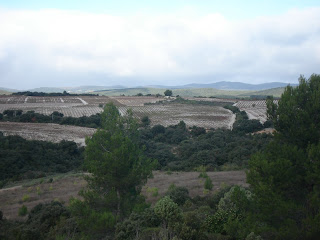
So, what type of barrel do you want? Size (225 L standard barrique, demi-muid ..), wood (ok mostly oak but ... slovenian chestnut anyone?), type of oak (French, American), which forest (Allier, Vosges, Limousin ....), cooper (Francois Frères, Seguin Moreau, Demptos ....), toast level, heads toasted? New? 2nd or 3rd fill? phew! And that's just a few of the options!
The permutations are endless and, as anyone who has tasted the same wine in different barrels will attest, it does make a difference. But barrel tasting is usual the preserve of professionals. However, thanks to the O'Connells of
O vineyards in
Cabardès, the humble consumer is able to discover for himself how ageing a wine in French oak, American oak or no oak at all affects the flavour of a wine.
The wine is question is a Vin de Pays de Cité de Carcassonne (the vineyards are a stone's throw from the famous cité) and is a blend of precisely 53% Merlot and 47% Cabernet Sauvignon. It can't be an AOC Cabardès as appellation rules require a blend of Atlantic and Mediterranean (ie syrah, grenache, carignan) varieties.
The unoaked wine had attractive aromas of raspberries and blackcurrants with a hint of leafiness. Pleasant creamy black, brambly fruit on the palate balanced by ripe but not overbearing palate. Fruity, good concentration of flavours but fairly simple.
Aged in new American oak for 8 months, the wine had a forward nose of black fruit, coffee and a slightly resinous oaky aroma. There was plenty of broad, chunky black fruit on the palate with notes of spice and vanilla. The tannins were very firm but the fruit just about balanced it.
Aged in French oak for 12 months, the wine had the most restrained nose of the 3 wines. Hints of black fruit and dill. The palate was also more closed - there was good concentration of fruit there but the flavours were hiding still. Tannins firm but finer grained than in the American oak wine. Acidity more pronounced. Structure finer but needs time in bottle for the fruit to evolve and harmonise with acid and tannins.
In conclusion, the wine aged in oak did have more complexity and richness than the unoaked version which was nice but quite simple. The American oak wine was more approachable now, despite the grippy tannins, as the fruit was more forward and appealing. Needs robust food. The French oak gave fine structure but the fruit is still shy. Worth trying in a year or two to see if the fruit has emerged from its hidey-hole.
Thanks to the O Connells for generously providing the wines.
 My favourite place in Beziers is Le Chameau Ivre, a wonderful wine shop and Tapas bar which is owned by Philippe Catusse.
My favourite place in Beziers is Le Chameau Ivre, a wonderful wine shop and Tapas bar which is owned by Philippe Catusse.


 I wasn't able to make the 'Outsiders' tasting in London last week. Judging by the comments on
I wasn't able to make the 'Outsiders' tasting in London last week. Judging by the comments on 







